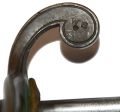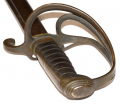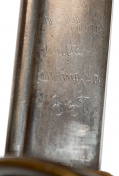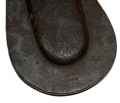site search
online catalog
AMES US M1833 DRAGOON SABER DATED 1837

$1,450.00 SOLD
Quantity Available: None
Item Code: 789-08
This is a very good example of a regulation U.S. cavalry saber- the Model 1833 Dragoon Saber for enlisted men. Total production was just 6,100 and most survivors lack the condition of this saber, which preserves not only the full grip wrap and wire, and a good edge and point, but the shallow and easily worn dry-needle engraved Ames maker address and date on the obverse ricasso and the “United States” midway up on the reverse, along with its deeper inspection marks on the hilt, blade, and scabbard.
Based on the British 1821 enlisted cavalry pattern and were purchased to arm the 1st US Dragoons, newly created following a period with no US cavalry, for issue to states under the terms of the 1808 militia act, and then for issue to the 2nd US Dragoons as well, organized in May 1836. Ames beat out Nathan Starr for the contracts, delivering 1,000 by January 1835 on a purchase order signed in February 1834, another 1,400 by late 1835 on an order of February 1835, and 1,700 delivered in 1836 and 1837 on an order of November 1835. Given the very clear 1837 date on this one, it would have been delivered as part of that order. (The last order was signed in March 1839, for 2,000 sabers, delivered by November of that year.)
The brass hilt has a nice untouched, aged patina. The stepped pommel has some minor rubbing to the edges and light dings on the top, but appears undisturbed. The medium brown leather grip shows some light wear to the upper rear surfaces of the grip ridges, natural points of contact in handling. The wire is in place and tight. The blade pad appears original, showing some slight edge loss and compression. The blade is smooth metal, a light silver gray in tone with scattered small dark gray spots, and a good edge and point, showing just some fine scratches from cleaning along the edge at the midpoint of the blade. The blade is dry-needle engraved on the obverse near the guard in script, “N.P. Ames / Cutler / Springfield / 1837,” with only the “1” light. The reverse is engraved in the same fashion, “United States” over a leafy branch. The two-line lower border for the writing is still visible. The lower points of the leafy branch are obscured by the shallow scratches from a cleaning at some point, but the lower portions are good on the right and upper portions are visible all the way along.
The scabbard is the regulation iron pattern with screw-fastened throat, narrow ring bands, and drag in place. The rings are solid, butt-joined, period replacements for the initial flimsier split rings. The scabbard shows areas of light pitting and scaling to the surface, but has no dents or holes, a good grayish brown color, and a visible “WS” sub-inspector stamp on one side of the drag and “MPL” final inspection stamp on the other.
The quillon disk bears the same “WS” sub-inpector stamp of William Smith, a civilian employee at Springfield Armory and foreman and inspector of the upper water shop from 1837-1841, during which time, he later testified, he also inspected swords at the Ames factory. The blade bears a “JH” inspector stamp Thillmann attributes to Joseph or John Hannis, though the latter would have been too young. Joseph, a civilian employee of the Ordnance Department, was working at Springfield at least as early as October 1836 and became an inspector of contract arms “less than two year later,” though we cannot eliminate John Hawkins as a candidate: he was a civilian employee at Springfield, also from at least October 1836 as a “proof master,” but worked “intermittently as an inspector of contract arms during this period.” The quillon of the hilt also bears the “MPL” final inspection mark, matching that on the scabbard drag, of Maj. Mann P. Lomax, appointed to the Ordnance Department in July 1837 and placed in charge of the Watertown Arsenal, in Massachusetts, and appointed chief inspector of contract arms. For what it’s worth, Hawkins signed a letter to Lomax in November 1838 asking for pay increase.
This is a very good example of the regulation sword adopted when the army decided it again needed a regular mounted regiment instead of companies of rangers for duty on the frontier, capable of fighting on foot when need be and of making rapid pursuits and long range expeditions and patrols. The pattern was officially replaced by the M1840, but remained in use by some state militia into the Civil War. [sr] [ph:L]
~~~~~~~~~~~~~~~~~~~~~~~~~~~~~~~~~~~
THIS ITEM, AS WITH ALL OTHER ITEMS AVAILABLE ON OUR WEB SITE,
MAY BE PURCHASED THROUGH OUR LAYAWAY PROGRAM.
CLICK HERE FOR OUR POLICIES AND TERMS.
THANK YOU!
Inquire About AMES US M1833 DRAGOON SABER DATED 1837
For inquiries, please email us at [email protected]
Most Popular
Historical Firearms Stolen From The National Civil War Museum In Harrisburg, Pa »
Theft From Gravesite Of Gen. John Reynolds »
Fine Condition Brass Infantry Bugle Insignia »
Selection Of Unframed Prints By Don Troiani »
Wonderful Condition Original Confederate-Manufactured Kepi For A Drummer Boy Or Child »
featured item
CONFEDERATE CAVALRY CAPTAIN’S FROCK COAT OF CAPT. EDWARD BIRD, “EFFINGHAM HUSSARS,” 2nd BATTALION AND 5th REGIMENT GEORGIA CAVALRY
This rare, identified, Confederate cavalry captain’s frock coat belonged to an officer who served from 1861 though 1865, rising from Captain to Colonel, with extensive action especially in Wheeler’s cavalry corps fighting against Sherman in the… (1179-232). Learn More »
























